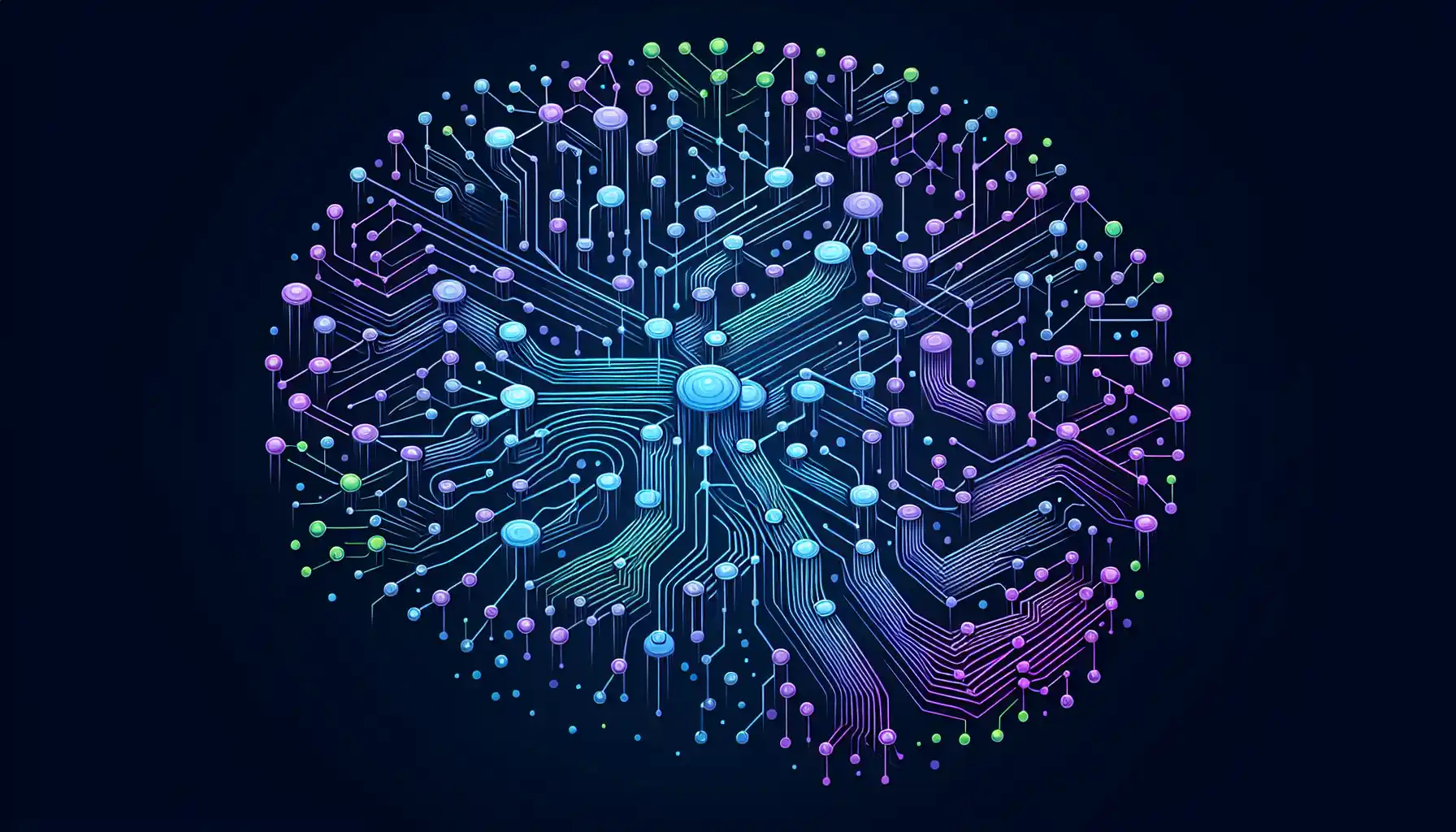The field of machine learning is continuously growing and evolving, and one of the most exciting developments in this area is the rise of neural networks.
These powerful computational models are inspired by the way the human brain processes information and have shown remarkable success in a wide range of applications, from image and speech recognition to language translation and playing games.
You can create your own neural network by following these steps:
- Understanding the fundamentals of neural networks and how they work.
- Choosing a framework that fits your needs.
- Defining your neural network architecture and its different layers.
- Preparing and pre-processing your data.
- Training your model using the prepared data.
- Evaluating the model’s performance and making adjustments.
- Using your model to make predictions or decisions.
In this article, we will guide you through the process of building a neural network.
You will learn how to code a simple neural network that can solve problems, recognize patterns, and make decisions.
By the end, you will have the skills to build a powerful tool that can analyze data, learn from it, and make predictions.
So let’s dive in!
What Is a Neural Network?

A neural network is a computer system modeled after the human brain. It can learn from data and make decisions based on what it has learned.
Just like the brain, a neural network has many interconnected neurons that work together to solve problems.
These artificial neurons, or “nodes,” are organized into layers. A typical neural network has three types of layers:
- Input Layer: This is where the data is fed into the network. Each input neuron represents a feature of the data. For example, in an image recognition task, each input neuron might represent the brightness of a pixel.
- Hidden Layers: These layers perform the actual computation of the neural network. Each neuron in a hidden layer takes input from all the neurons in the previous layer, performs some calculation, and then passes the result to the neurons in the next layer.
- Output Layer: This layer produces the final output of the network. The number of neurons in the output layer depends on the type of problem the network is solving. For example, in a binary classification task (e.g., “Is this email spam or not?”), there would be two output neurons, each representing one of the two classes.
How Do Neural Networks Work?

To understand how neural networks work, let’s break down the process into three main steps: data, training, and prediction.
1. Data
To train a neural network, you need data. The data can be anything from images and sound to numbers and text.
For example, if you want to build a neural network that can recognize cats in images, you’d need a lot of pictures of cats as training data.
The data is divided into two parts: training data and testing data.
The training data is used to teach the network what a cat looks like. The network learns by adjusting the strengths of the connections between its neurons until it can correctly identify the cats in the training data.
The testing data is used to check how well the network has learned. If the network can accurately identify cats in the testing data, it’s ready to make predictions.
2. Training
The process of training a neural network is often referred to as “learning.”
During the training phase, the network goes through the following steps:
- Forward Pass: The network processes the input data (e.g., an image of a cat) and makes a prediction. This is called a forward pass.
- Error Calculation: The network compares its prediction to the correct answer (e.g., “Yes, this is a cat”).
- Backpropagation: The network then goes back and adjusts the strengths of the connections between neurons to reduce the error. This process is called backpropagation.
- Repeat: Steps 1-3 are repeated for many iterations (or “epochs”) until the network can make accurate predictions on the testing data.
3. Prediction
After the network has been trained, it can be used to make predictions on new, unseen data.
To make a prediction, the network goes through a forward pass just like during training, but this time it doesn’t adjust its connections. It simply processes the input data and produces an output.
For example, if you give the network a new image, it will predict whether there’s a cat in the image or not.
How to Create Your Own Neural Network

To create your own neural network, you can follow these steps:
- Selecting a framework
- Choosing the architecture
- Implementing the neural network
- Training the model
1. Selecting a Framework
A neural network is a complex structure, and writing code for it from scratch can be time-consuming and error-prone.
This is why most people use specialized software libraries, known as “neural network frameworks,” to build and train their models.
Some of the most popular neural network frameworks are:
- TensorFlow: Developed by Google, TensorFlow is an open-source deep learning library with a large and active community. It provides a comprehensive ecosystem for machine learning, with a wide range of tools, libraries, and resources. It’s often the go-to choice for those working on deep learning projects.
- Keras: Initially developed as a high-level interface for neural networks, Keras is now integrated with TensorFlow and is considered part of its core library. Keras allows you to quickly and easily build, train, and deploy neural network models, making it an excellent choice for beginners.
- PyTorch: PyTorch is an open-source deep learning library developed by Facebook. It’s known for its dynamic computation graph, which allows for more flexibility during model training. PyTorch is also popular for its easy-to-use API and Pythonic syntax.
All of these frameworks are powerful tools for building neural networks, and the choice between them often comes down to personal preference and project requirements.
2. Choosing the Architecture
Before you start implementing your neural network, you need to decide on its architecture.
The architecture of a neural network refers to its overall structure, including the number of layers, the number of neurons in each layer, and the connections between neurons.
This is an important step because the architecture of a neural network can greatly affect its performance. A well-designed architecture can make your network more efficient and accurate.
When choosing an architecture, consider the following:
- Input Data: What is the nature of your input data? For example, is it image data, text data, or something else? The type of input data will influence the design of your input layer.
- Output Data: What type of output are you trying to predict? Is it a binary classification (yes/no), multi-class classification, or continuous values? The type of output data will influence the design of your output layer.
- Complexity of the Problem: How complex is the problem you are trying to solve? More complex problems may require larger networks with more layers and neurons.
- Size of the Dataset: How much data do you have available for training? Larger datasets may require more parameters in your network.
- Computational Resources: What are your computational resources (e.g., CPU, GPU, TPU)? Larger networks require more computational resources.
The most common neural network architectures are:
- Feedforward Neural Networks (FNN): These are the simplest type of neural networks, where data moves in one direction only, from the input layer through the hidden layers to the output layer. They are used for tasks like image and speech recognition.
- Recurrent Neural Networks (RNN): In these networks, data can flow in multiple directions, allowing them to handle sequential data. They are used for tasks like language modeling and time series analysis.
- Convolutional Neural Networks (CNN): These networks are designed for tasks that involve images. They use a technique called “convolution” to process image data more efficiently. They are used for tasks like object detection and image classification.
- Long Short-Term Memory Networks (LSTM): These are a type of recurrent neural network that are designed to handle sequential data more effectively. They are used for tasks like speech recognition and language translation.
3. Implementing the Neural Network
Now that you’ve chosen your neural network framework and architecture, it’s time to implement your network.
This is where the real fun begins!
You’ll start by creating your neural network model using the framework’s built-in tools and libraries.
Let’s take a look at how to build a neural network in Python, which is one of the most popular programming languages for neural network development due to its extensive libraries like NumPy and TensorFlow.
a. Install Python Libraries
Before you start building your neural network in Python, make sure you have the necessary libraries installed.
Two of the most important libraries for neural networks are NumPy and TensorFlow. You can install these libraries using the following commands:
NumPy: This is a fundamental package for scientific computing with Python. It provides support for large, multi-dimensional arrays and matrices, along with a collection of mathematical functions to operate on these arrays. You can install it using the following command:
TensorFlow: This is an open-source deep learning library developed by Google. It provides a comprehensive ecosystem of tools, libraries, and community resources to support the development of deep learning models. You can install it using the following command:
b. Building Your Neural Network
To build a neural network in Python, you can use the TensorFlow library, which offers an easy-to-use high-level interface for constructing neural networks.
The following is an example of a simple feedforward neural network with one hidden layer using TensorFlow:
In this code, we have created a Sequential model, which is a linear stack of layers. We then added three layers to the model:
- A Dense layer with 64 neurons and a ReLU activation function.
- Another Dense layer with 64 neurons and a ReLU activation function.
- A final Dense output layer with 10 neurons (assuming a 10-class classification problem) and a softmax activation function.
c. Compile and Train Your Neural Network
After building your neural network, you need to compile it with the appropriate loss function, optimizer, and metrics to monitor during training.
Then, you can train the model by providing the training data and the number of epochs (iterations over the entire dataset) you want to train for.
The following code demonstrates this:
In this code, we have compiled the model using the adam optimizer, the sparse_categorical_crossentropy loss function (for a multi-class classification problem), and the accuracy metric.
Then, we trained the model using the training data and validating it on the validation data for 10 epochs.
d. Make Predictions
Finally, you can use your trained model to make predictions on new data. You can do this by calling the predict method on your model with the input data.
The following code demonstrates this:
This will output the model’s predictions for the input data.
4. Training the Model
Training a neural network model is an iterative process that involves the following steps:
- Data Preparation: You need to load and preprocess your data. This may involve tasks such as normalization, splitting the data into training and testing sets, and creating data loaders.
- Define the Model: You need to choose the type of model (e.g., feedforward, convolutional, recurrent) and define its architecture (e.g., number of layers, number of neurons in each layer).
- Choose the Loss Function and Optimizer: You need to choose an appropriate loss function for your problem (e.g., mean squared error for regression, cross-entropy for classification) and an optimizer (e.g., SGD, Adam).
- Training Loop: You need to iterate over the training data for a certain number of epochs, making predictions with the model, calculating the loss, and updating the model’s weights using the optimizer.
- Evaluation: After training, you need to evaluate the model’s performance on the testing data to see how well it generalizes to new, unseen data.
The following is an example of training a simple neural network in Python using the Keras library:
In this code, we have loaded a sample dataset of handwritten digits called MNIST using the keras.datasets module.
We then preprocessed the data by scaling the pixel values to the range [0, 1] and reshaping the images from 28×28 to a flat vector of length 784.
Next, we defined a simple feedforward neural network model with one hidden layer using the keras.models.Sequential class.
The model was then compiled with the adam optimizer, the sparse_categorical_crossentropy loss function, and the accuracy metric.
We trained the model on the training data and evaluated its performance on the testing data, achieving an accuracy of around 98%.
Final Thoughts

As you’ve learned, creating your own neural network is an achievable and rewarding process. Whether you’re a seasoned programmer or just starting, diving into the world of neural networks can be a fun and enlightening experience.
The most important thing is to have a clear goal in mind. What problem do you want your neural network to solve? Whether it’s image recognition, natural language processing, or something else entirely, having a clear goal will help guide your decisions throughout the development process.
So, get started on building your neural network and have fun exploring the possibilities of this exciting field!
Frequently Asked Questions

What are the key steps in creating a neural network?
The key steps in creating a neural network are:
- Defining the problem and data you are working with.
- Preparing your data for input into the network.
- Choosing the architecture and model type.
- Implementing the network using a programming language or a framework like TensorFlow or Keras.
- Training the network by adjusting the weights and biases in the model.
- Evaluating the performance of the network and making adjustments as needed.
What is the best way to get started with neural network programming?
The best way to get started with neural network programming is to take a structured course in deep learning and neural networks.
Alternatively, you can follow a step-by-step tutorial that walks you through the process of building a neural network. There are many resources available online that can help you get started.
Can you give an example of building a simple neural network from scratch?
Sure, a simple feedforward neural network can be built from scratch using Python and NumPy.
This example is for a simple neural network with one input layer, one hidden layer, and one output layer.
First, you will need to initialize your weights and biases, then you can implement the forward and backward passes, and finally, train your network using gradient descent.
How do I train a neural network for a specific task?
To train a neural network for a specific task, you will need to:
- Define your neural network architecture, including the number of layers and the number of neurons in each layer.
- Choose an appropriate loss function and optimization algorithm for your task.
- Split your data into training, validation, and test sets.
- Feed your training data into the network and use the optimization algorithm to adjust the network’s weights and biases.
- Monitor the network’s performance on the validation set and stop training when the performance stops improving.
- Evaluate the network’s performance on the test set to get a final measure of its accuracy.
How can I implement a neural network using Python?
You can implement a neural network using Python by using libraries like NumPy for numerical computations and SciPy for scientific and technical computing. Alternatively, you can use more specialized libraries like TensorFlow, Keras, or PyTorch.
These libraries provide a higher level of abstraction and make it easier to create and train neural networks.











